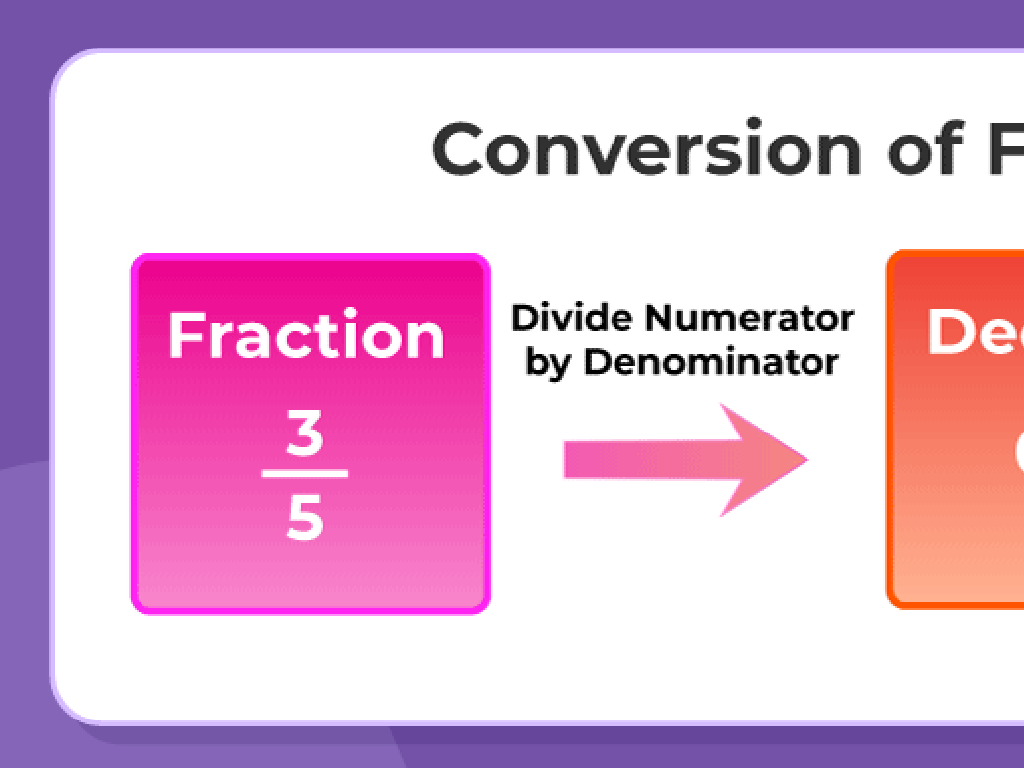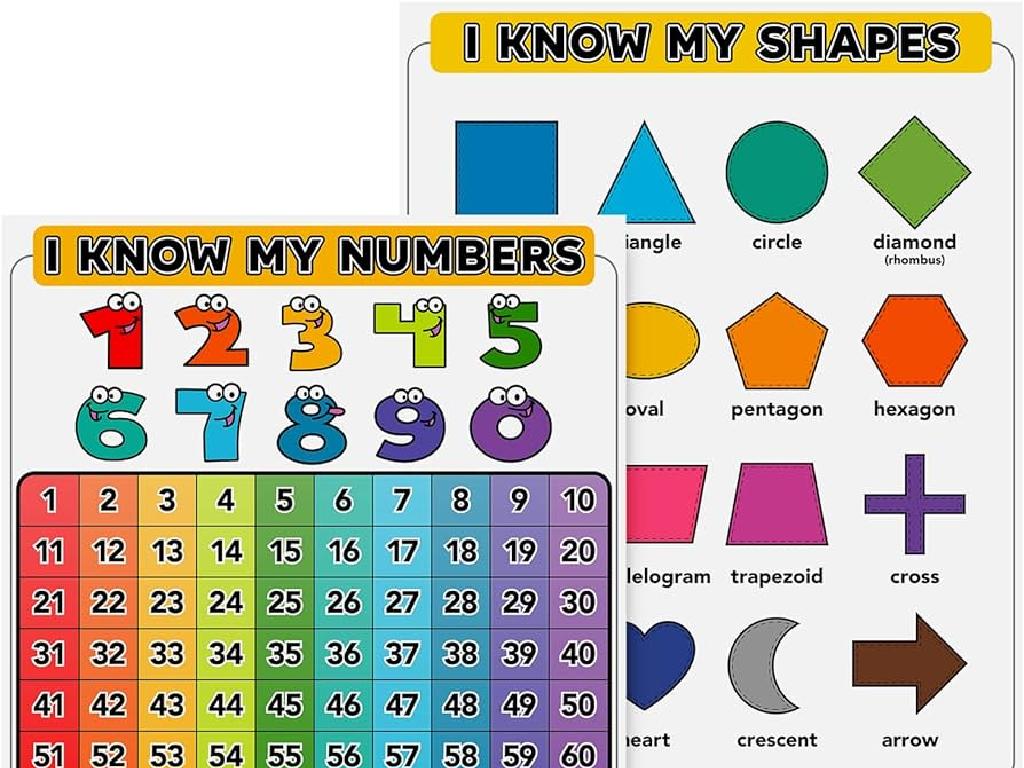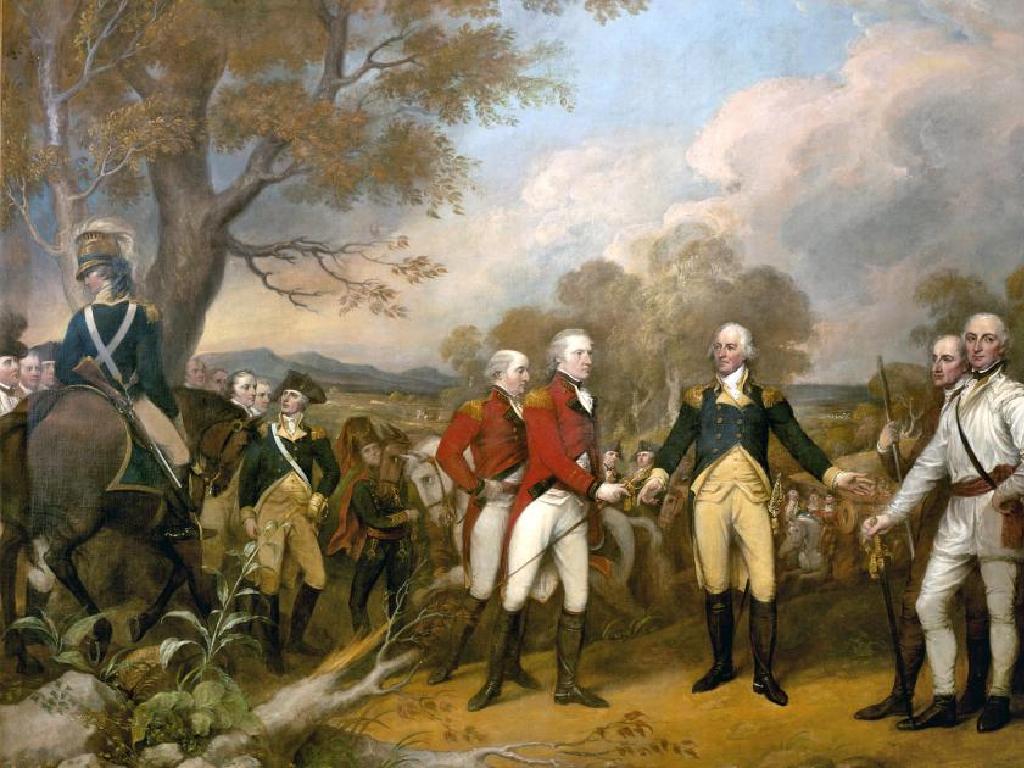Interpret Categorical Data
Subject: Math
Grade: Sixth grade
Topic: Data And Graphs
Please LOG IN to download the presentation. Access is available to registered users only.
View More Content
Interpreting Categorical Data
– Understanding data’s role
– Today’s focus: Categorical Data
– Defining Categorical Data
– Data sorted by groups, like favorite color
– Importance in everyday life
– Helps make decisions based on preferences
|
This slide introduces the concept of interpreting categorical data, which is a fundamental aspect of understanding the world through data analysis. Emphasize the importance of data in making informed decisions and solving real-world problems. Categorical data is information that can be sorted into categories, such as favorite colors, types of pets, or genres of music. It’s crucial for students to grasp that this type of data is qualitative and often involves grouping things by common attributes. Discuss how we use categorical data in everyday life to make choices, such as what products to buy based on consumer surveys or how to vote based on political polls. Encourage students to think of examples of categorical data they encounter daily.
Understanding Categorical Data
– Define Categorical Data
– Data sorted by groups, not numbers
– Examples of Categorical Data
– Rainbow colors, animal types, shoe brands
– Categorical vs. Numerical Data
– Categorical is by type, numerical is by value
– Significance in everyday life
|
Categorical data is a type of data that is grouped by categories and can be labeled or named but not measured with numbers. For example, the colors of a rainbow or types of animals are categorical because they represent distinct groups, not numerical values. In contrast, numerical data represents quantities and can be measured or counted. Understanding the difference is crucial for proper data analysis and representation. This concept is fundamental in statistics and helps students to categorize data in their daily lives, such as sorting clothes by color or books by genre. Encourage students to think of more examples and discuss why recognizing the type of data is important.
Graphing Categorical Data
– Understanding Bar Charts
– A bar chart displays data with rectangular bars.
– Exploring Pie Charts
– Pie charts show parts of a whole as slices of a pie.
– Choosing the Right Graph
– Use bar charts for comparisons, pie charts for proportions.
– Interpreting Graph Features
– Titles, labels, and legends guide us in reading graphs.
|
This slide introduces students to the different types of graphs used to represent categorical data, specifically bar charts and pie charts. Emphasize the structure of a bar chart, with its bars representing different categories. Explain that pie charts are best when showing how a whole is divided into parts. Discuss when to use each type of graph: bar charts are great for comparing different groups, while pie charts are ideal for showing the percentage or proportion of each category. Highlight the importance of graph features such as titles, which tell us what the graph is about; labels, which identify the categories or values; and legends, which help decode the colors or patterns used. Encourage students to always look for these features to understand the data being presented.
Creating and Interpreting Bar Charts
– Steps to collect data
– Gather information relevant to your topic
– How to choose categories
– Decide on the groups for comparison
– Drawing the chart: scales and bars
– Label your axes and draw bars proportionally
– Interpreting the results
– Analyze the chart to draw conclusions
|
This slide is aimed at teaching students the process of creating a bar chart to interpret categorical data. Start by discussing the importance of collecting accurate data and how it can be gathered through surveys or experiments. Next, explain the process of choosing appropriate categories for the data, which will form the basis of comparison on the bar chart. When drawing the bar chart, emphasize the need for correctly labeled axes, choosing an appropriate scale, and drawing bars that accurately represent the data. Finally, guide students on how to interpret the bar chart by comparing the heights or lengths of the bars to draw conclusions about the data. Encourage students to practice by collecting their own data, creating a bar chart, and sharing their interpretations.
Creating a Pie Chart
– Collect data for the chart
– Determine the total value
– The sum of all categories in your data
– Calculate each slice size
– Use percentages of the whole for each category
– Interpret the chart results
– Understand what each slice represents
|
This slide is aimed at teaching students how to create and interpret pie charts. Start by guiding them to collect data on a topic of interest, ensuring they understand the importance of accurate data collection. Next, explain that the ‘whole’ refers to the total sum or value of all the data collected. Then, show them how to calculate the size of each pie slice by converting the data into percentages of the whole. Finally, discuss how to interpret the pie chart, understanding what each slice represents in terms of the data. Encourage students to think critically about what the visual representation of the data tells them about the different categories.
Interpreting Categorical Data in Graphs
– Recognize patterns in data
– Look for trends or repetitions
– Make inferences from graphs
– Draw conclusions based on graph info
– Analyze school lunch choices
– What’s the most popular lunch?
– Discuss favorite books data
– Which genres are most liked?
|
This slide aims to teach students how to interpret categorical data by recognizing patterns and making inferences from graphs. Use real-life examples like school lunch choices to show how data is collected and represented in graphs. Discuss how to analyze the data to find the most popular items. Similarly, use favorite books data to explore different genres and preferences among classmates. Encourage students to think critically about what the data is telling them and how it can be applied in real-world situations. This will help them understand the importance of data interpretation in everyday decision-making.
Let’s Practice: Conducting a Survey
– Conduct a class survey
– Choose a survey category
– Pick a topic like favorite hobbies or pets
– Create a bar or pie chart
– Use the data to make your own chart
– Share and interpret results
– Explain what your data shows to the class
|
This class activity is designed to give students hands-on experience with collecting and interpreting categorical data. Students will conduct a survey among their classmates on a topic of their choice, such as favorite hobbies or types of pets owned. They will then use the collected data to create a bar chart or pie chart, which will help them visualize the data distribution. Finally, students will present their findings to the class, explaining what the data suggests about their peers’ preferences or experiences. For the teacher: Prepare a list of survey questions for students who may have difficulty choosing a category. Ensure that students understand how to create charts and what each part represents. Have some examples of interpreted data ready to show as a model for students. Encourage students to think critically about what conclusions can be drawn from their data and what cannot.
Class Activity: Survey and Graph Creation
– Form groups and choose a survey topic
– Survey classmates for data collection
– Create a bar or pie chart with collected data
– Use the data to make a chart that’s easy to read
– Present and interpret your graph in class
– Explain what your data reveals about class preferences or opinions
|
This activity is designed to give students hands-on experience with collecting and interpreting categorical data. Divide the class into small groups and have each group decide on a survey question that can be answered categorically, such as favorite color or preferred school lunch. Each group will then collect responses from their classmates. After collecting the data, students will create a visual representation in the form of a bar or pie chart, which they will present to the class. Encourage creativity in the display of their data. During presentations, guide students to explain what their graph indicates about the class’s preferences or opinions. This will help them understand how to interpret and present categorical data effectively. Possible survey topics could include favorite book genres, pet ownership, or modes of transportation to school.
Conclusion: Understanding Categorical Data
– Recap: Categorical Data Defined
– Data sorted by groups, like favorite colors
– Why Interpret Data?
– Helps make informed decisions based on data
– Engage in Q&A Session
– Reflect on what we’ve learned
– Summarize Today’s Lessons
|
As we wrap up today’s lesson, revisit the definition of categorical data, emphasizing its organization by categories. Highlight the significance of interpreting data to make sense of information and guide decisions. Encourage students to ask questions about today’s lesson to reinforce their understanding. Conclude by summarizing the key points covered, such as types of categorical data, methods of interpretation, and real-life applications. This recap solidifies the concepts and ensures students are prepared for future lessons involving data analysis.






